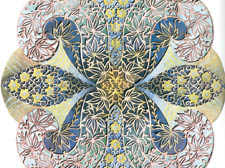|
|
 |
| |

Rosettes by Marta Golab |
Tracing patterns in a symbolic world of
Dan Carrier explores the Polish-Jewish tradition of papercutting
THEY were first noted in the 13th century, and became a central plank of artistic expression for the ancient Jewish communities in Poland.
Now an exhibition in on the art of papercuts is gracing New End’s Burgh House.
Curated by papercuts expert Connie Webber, it features the work of Krakow-based fine artist Marta Golab.
Connie first discovered Marta’s work while staying in Poland – she travels there regularly, has Polish grandparents and her husband works as an anthropologist in the country.
“It was 1988,” she recalls. “We were staying in our flat in Krakow and became friendly with Marta, who is one of our neighbours. She knew we were Jewish and wanted to bring us a present – so she brought round a papercut. We knew it was Polish-Jewish art and we thought it was a wonderfully thoughtful present.”
It cemented their burgeoning friendship and Connie learnt how Marta had come across this tradition in a city that had lost its Jewish residents during the war.
A papercut can take months, from the cutting to painting the final design, and often uses Hebrew words, or images relating to Judaism: in her 2005 piece The Mizrach with the View of a Shtetl, Marta features The Temple of Jerusalem, a menorah and the tablets of the Ten Commandments.
Connie then began to collect and collate papercuts and the result is this exhibition.
She added: “They are part of a long tradition of folk and ceremonial art, and one Marta has researched to produce her own, ornate creations.”
Marta said: “Discovering Jewish papercuts was a new, exotic, thing for me. Not just the content and symbolism but also the technique used was a surprise for me. What originally was just an artistic adventure began to fill my entire world. It has become an obligation to those who once lived here in the Jewish city of Krakow.”
• |

|
 |
| |
|
 |
|

